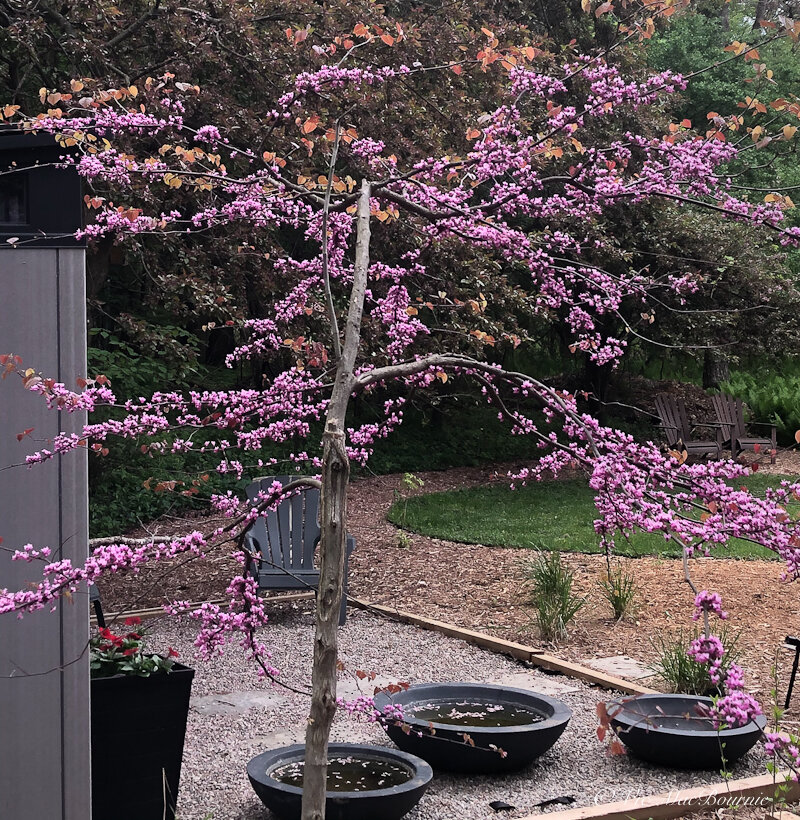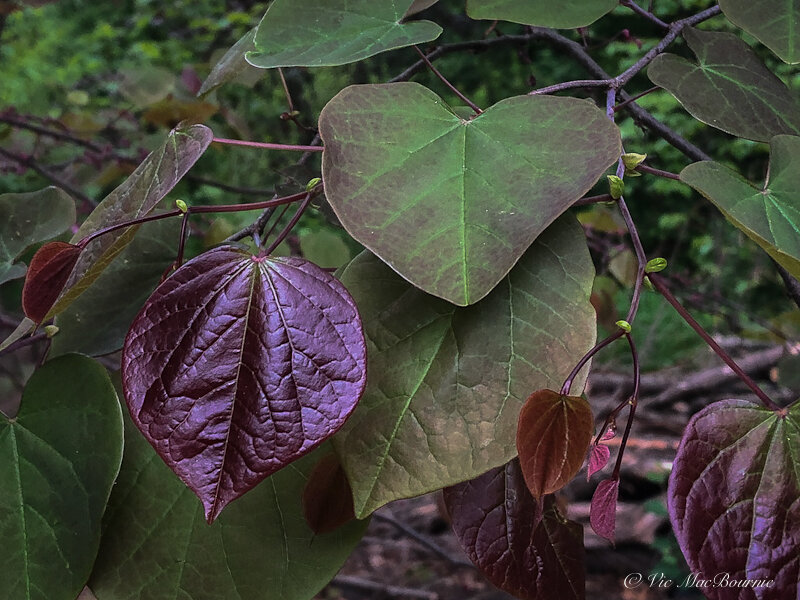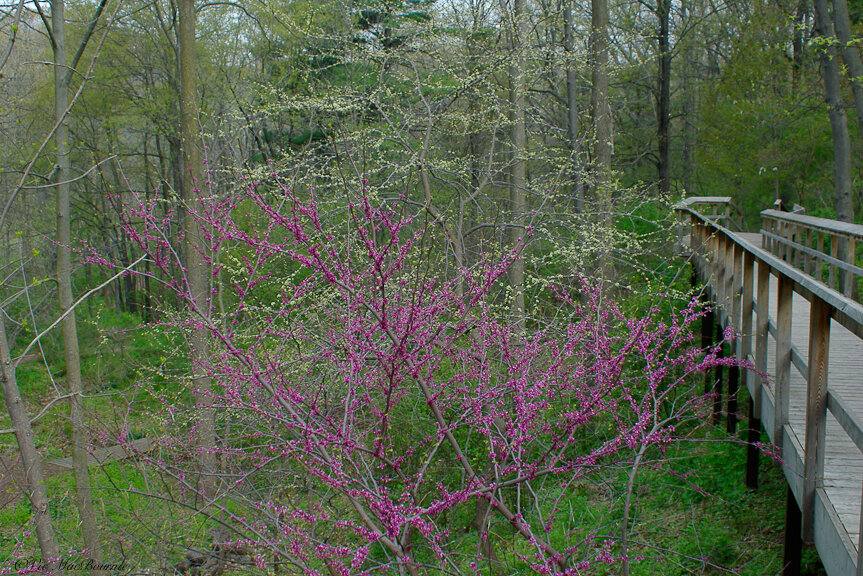Plant the perfect Redbud (a Carolinian zone favourite)
Forest Pansy is a real winner in a forest of Redbuds
I’ve always liked Redbuds, but it took a local garden tour for me to fall in love.
With the Redbud, that is. It wasn’t just any Redbud tree, either. It was the Forest Pansy Redbud.
Cercis Canadensis, or the Eastern Redbud, as it is known in gardening circles, is a Woodland tree growing in zones 4-9, native to southern Ontario and most of the United States from northern Florida as far west as California. There are actually a few different varieties of redbud trees, including a Texas Redbud and a Mexican Redbud as well as a Western Redbud (which is a separate species, cercis orbiculata).
Eastern Redbud is part of the Carolinian Canada zone
The Eastern Redbud is the largest of the group, requiring the most water. The tree, which is part of the Carolinian Canada zone, also has larger, less glossy leaves than the other varieties. It grows to about 30 feet with a spread of about 35 feet and can be found as a multi-stem tree or large shrub, to a single-stem specimen. It can take full sun but likes a little light shade as an understory tree in the woodland garden where it puts on its glorious show in early spring with an abundance of pink flowers on bare branches.
For those not familiar with the Redbud, think back to early spring and seeing a small tree with a profusion of tiny pink flowers covering the branches of the entire tree before the heart-shaped leaves had begun to emerge. Remember thinking to yourself, ‘holy smokes what is that’? Well folks, that was a Redbud.
Our Redbud Forest Pansy in its spring bloom in mid May. The Forest pansy leaves emerge with rusty-coloured leaves that can be stunning in the woodland garden. They are a favourite for leaf-cutter bees that cut perfectly round holes in the leaves to line their nest.
Now if a spectacular fireworks of pink, pea-sized blossoms on bare stems in early spring isn’t enough, how about the fact that the tree’s horizontal growth habit gives it a beautiful architectural quality in the garden if, of course, it is left to grow in a natural state and not attacked by a chainsaw or some other tool of destruction.
Still not enough?
The leaves are 2 to 6-inch, heart-shaped and turn a dark green throughout the summer only to turn a spectacular bright canary yellow for fall. They attract many species of birds, bees and butterflies and will grow in most decent soils. They are deer resistant. The deer in my area, at least, have never bothered mine.
The trees are even so beloved that there are Redbud festivals in Texas, Virgina and Wisconsin, just to name a few.
They are also one of the few trees that leaf-cutter bees use to line their nest cavities. Look closely for circles cut out of the edge of the leaves, and you’ll know you have native leaf-cutter bees nesting in your garden. That’s a very good thing. You can rejoice in the fact that the bees cut holes in your leaves rather than trying to find the culprit crawling on the leaves.
I consider the Redbud equal to the Dogwoods as the best understory trees for the Woodland garden. At present I have three in the garden, including a Forest Pansy. The others are a multi-stem Eastern Redbud I added this year to join our single stem tree.
Early spring leaves on the Redbud Forest Pansy.
The Forest Pansy’s leaves are different
And we have not yet even talked about the Redbud I fell in love with. The Forest Pansy is actually a cultivar of the common Eastern Redbud. It has all the best qualities of the original Redbud but the leaves are a more intense red-purple hue. The tiny leaves grow into deep, shiny, leathery looking purple-colored, heart-shaped leaves.
The one I saw on the garden tour was incredible. At first, I didn’t know what to think of the leathery leaves. They almost looked like the tree was going into decline, but of course, it was not.
With that in mind, the Forest Pansy may not be a tree for everyone. Its unique summer colour might be too much for some gardeners to overlook. It is, however, the perfect specimen tree to get the attention of passersby on a garden tour. It might also work as a garden focal point in a Meditation Garden or an Asian-inspired Japanese garden.
Whether it’s a Forest Pansy cultivar or the common Eastern Redbud, consider planting them on the edge of your woodland alongside some dogwoods where you can fully appreciate them. They work beautifully in the natural landscape in groupings of three to five planted together to create an incredible view from a deck or window overlooking the garden. Underplant them with spring bulbs to create truly memorable spring garden designs.
A beautiful Redbud in bloom along a nature trail at the Royal Botanical Gardens in Burlington Ont.
A perfect example of mature Redbuds used in the landscape can be seen in the garden of Linda Vater. Not only are her Redbuds beautifully pruned to accentuate their natural horizontal branching habits, but her use of evening lighting makes the trees a standout in her garden both day and night. The above link takes you to an evening image of her garden with lighted Redbuds. Her YouTube channel is definitely worth checking out for more views of her Redbuds in the back garden.
If you remember one of my earlier blogs on some of the best nurseries to purchase native plants, we talked about Ontario Native Plants mail order company from the Hamilton area. They list Eastern Redbud for about $7.00. If you have the time to wait for them to grow, that’s a pretty darn good price.
Larger specimens can be purchased at most good local nurseries in tree form or multi-stemmed.
Looking for more information on our native Redbud? You might consider this e-book Kindle version from Amazon.
More links to my articles on native plants
Why picking native wildflowers is wrong
Serviceberry the perfect native tree for the garden
The Mayapple: Native plant worth exploring
Three spring native wildflowers for the garden
A western source for native plants
Native plants source in Ontario
The Eastern columbine native plant for spring
Three native understory trees for Carolinian zone gardeners
Ecological gardening and native plants
Eastern White Pine is for the birds
Native viburnums are ideal to attract birds
The Carolinian Zone in Canada and the United States
Dogwoods for the woodland wildlife garden
Bringing Nature Home by Douglas Tellamy
A little Love for the Black-Eyed Susan
Native moss in our gardens
This page contains affiliate links. If you purchase a product through one of them, I will receive a commission (at no additional cost to you). Thank you for your support. This blog would not be possible without your continued support.



